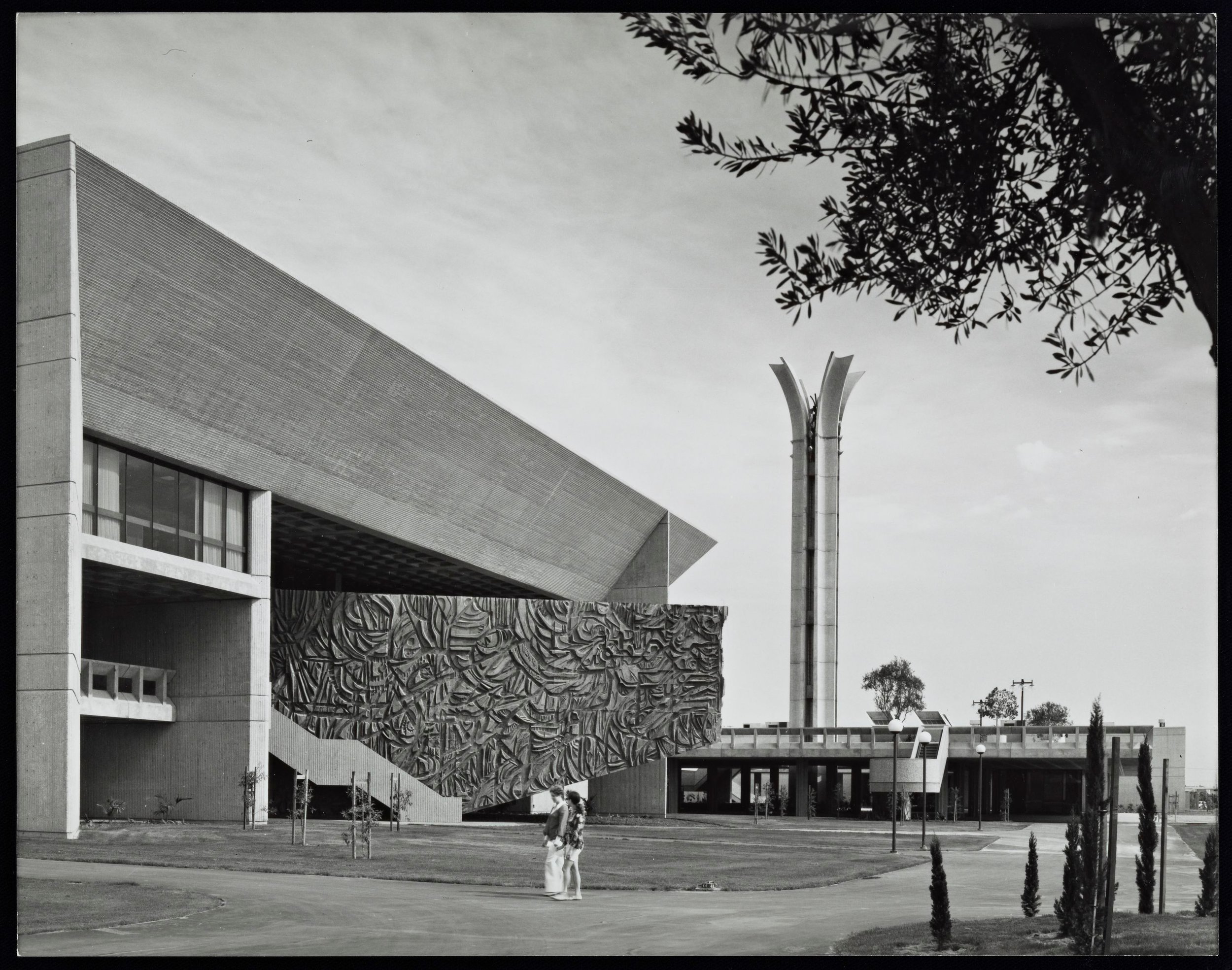J. Sergio O’Cadiz Moctezuma: El Artist
The Cypress College Library Mural, an expressive counterpoint to its paler, grid-based surroundings. Photographed by Julius Shulman in 1970. © J. Paul Getty Trust. Getty Research Institute, Los Angeles (2004.R.10)
A detail from Colonia Juarez Community Mural, 1974
O’Cadiz Family Collection
In 1967 J. Sergio O’Cadiz Moctezuma created the sculptural mural that juts out from the front of the Cypress College Complex building. Suggesting a rocky cliff or a pre-Columbian ruin, the red-brown Library Mural thrusts its way into the pale grey order of the campus, offering a witty challenge to its Brutalist style.
While the many-colored concrete relief appalled then-College President, Daniel Walker, it has since been recognized as an important artwork and conserved. But what exactly is this expressive object? How was it made? And who was Sergio O’Cadiz Moctezuma?
Although many of his artworks have been defaced or destroyed in recent years – most recently in July 2019, in Raitt Street, Santa Ana – J. Sergio O’Cadiz Moctezuma made significant contributions to the cultural life and art of Orange County for over fifty-years. In addition to exploring the unique process that he developed to make his concrete relief murals, this exhibition presents a selection of O’Cadiz Moctezuma’s paintings, drawings, public artworks, and graphic designs. Demonstrating the artist’s diverse, boundary-crossing creative life, these artworks also speak to the ways in which dominant culture can absorb and erase alternatives to its values and preferred aesthetics.
Born in Mexico City in 1934, Sergio O’Cadiz Moctezuma studied at the county’s best schools of art and architecture, including with the great muralist Diego Rivera. He moved to Orange County in 1962 looking for a place where he could follow his artistic vision free of traditionalist restrictions. Initially it seemed he had found it. Through the 1960s and early 1970s galleries in Orange County exhibited his studio-based work, and he made a number of important public pieces that skipped lightly over traditional divisions between painting and sculpture, abstraction and figuration, and surface and form.
When his challenge to the status quo bled through from the aesthetic realm and into the political, O’Cadiz Moctezuma experienced an increase of restrictions and a loss of opportunity. The pivotal year was 1974, when, influenced by twentieth century Mexican muralism and its Mayan and Aztec precursors, O’Cadiz Moctezuma painted two visual expressions of the Chicano Movement: The MECHA mural at Santa Anna Community College, and a 625-ft long mural at Colonia Juarez in Fountain Valley.
In keeping with his boundary-rejecting practice however, O’Cadiz Moctezuma was often uncomfortable with the restrictions implied by the label “Chicano artist.” Understanding himself as the embodiment of ethno-cultural tides that flowed from Pre-Columbian Mexico, Europe, and contemporary North America, the artist frequently used the motif of a galleon in full-sail. Speaking to personal and historical transitions, the ship sails forth, moving forever between. Working with concrete, ink, and paint, O’Cadiz sought to elide the dualisms that dominated twentieth century art in North America. Under his influence, they flowed together and apart, playful and serious, as seawaters eddy around the prow of a ship.
Cypress College Art Gallery would like to thank Dr. Maria del Pilar O’Cadiz for granting access to the O’Cadiz family collection and answering numerous questions about her father’s life and work.

